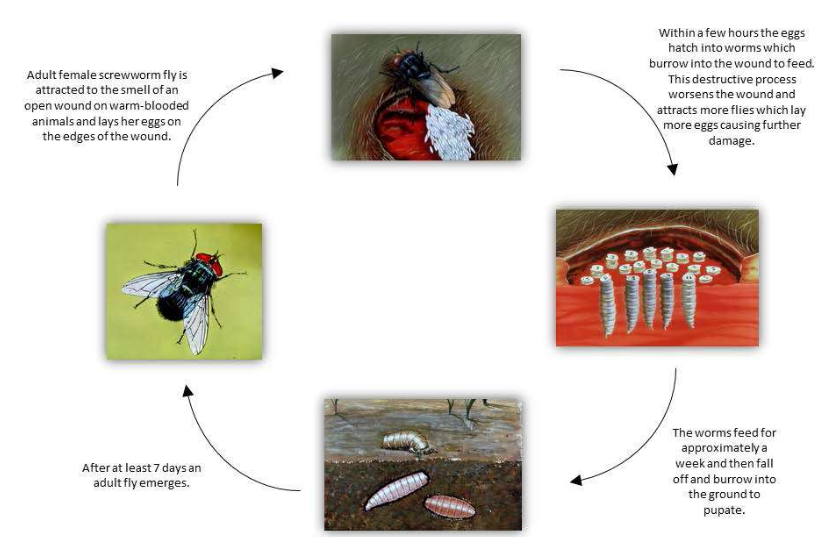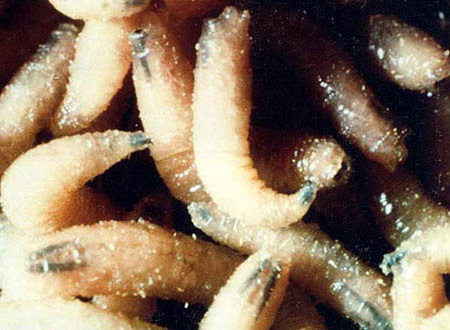 Source: USDA Animal and Plant Health Inspection Service 01/09/2017
Source: USDA Animal and Plant Health Inspection Service 01/09/2017
The United States Department of Agriculture’s (USDA) Animal and Plant Health Inspection Service (APHIS) confirmed the presence of New World screwworm (Cochliomyia hominivorax) in a stray dog near Homestead, Florida. The dog was isolated and his infested wounds were treated. Federal and state officials have started active surveillance in the area.
This is the first confirmed case on Florida’s mainland. Screwworm was first confirmed on October 3, 2016 in Key deer from National Key Deer Refuge on Big Pine Key, Florida. This initial presence of screwworm was the first local detection in the United States in more than 30 years and Florida’s Commissioner of Agriculture, Adam Putnam declared an agricultural state of emergency in Monroe County, Florida.
Since October, 13 Keys had known infestations mostly in the key deer population, with five confirmed infestations in domestic animals. Animal health and wildlife officials at the state and federal levels have been working aggressively to eradicate this pest. Extensive response efforts have included fly assessments to determine the extent of the infestation, release of sterile flies to prevent reproduction and disease surveillance to look for additional cases in animals. Officials have received significantly fewer reports of adult screwworm flies in the area and fewer cases of infected Key deer. To date, fly assessments have been conducted on 40 Keys. USDA has released over 80 million sterile flies from 25 ground release sites on twelve islands and the city of Marathon. The initial epidemiology report on the Florida Keys infestation may be viewed at https://www.aphis.usda.gov/stakeholders/downloads/2017/nws-epi-report.pdf.

Life cycle of New World Screwworm from Fernandez and White, 2010. Investigation into Introduction of New World Screwworm into Florida Keys
Residents who have warm-blooded animals (pets, livestock, etc.) should watch their animals carefully. Florida residents should report any potential cases to 1-800-HELP-FLA (1-800-435-7352) or non-Florida residents should call (850) 410-3800. Visitors to the area should ensure any pets that are with them are also checked, in order to prevent the spread of this infestation.
While human cases of New World screwworm are rare, they have occurred, and public health officials are involved in the response. No human cases have been reported in Florida. For more information about this disease in humans, please contact your local public health department. Using fly repellents and keeping skin wounds clean and protected from flies can help prevent infection with screwworm in both people and animals.
New World screwworm are fly larvae (maggots) that can infest livestock and other warm-blooded animals, including people. They most often enter an animal through an open wound and feed on the animal’s living flesh. While they can fly much farther under ideal conditions, adult flies generally do not travel more than a couple of miles if there are suitable host animals in the area. New World screwworm is more likely to spread long distances when infested animals move to new areas and carry the pest there.
In the 1950s, USDA developed a new method to help eradicate screwworm using a form of biological control, called the sterile insect technique, which releases infertile flies in infested areas. When they mate with wild females, no offspring result. With fewer fertile mates available in each succeeding generation, the fly, in essence, breeds itself out of existence. USDA used this technique to eradicate screwworm from the U.S. and worked with other countries in Central America and the Caribbean to eradicate it there as well. Today, USDA and its partners maintain a permanent sterile fly barrier at the Darien Gap between Panama and Colombia to prevent the establishment of any screwworm flies that enter from South America.
For more information on this subject, use the following links:
USDA Confirms Screwworms in the Florida Keys
Investigation into Introduction of New World Screwworm into Florida Keys
APHIS New World Screwworm Fact-sheet
- November 2025 Weather Summary & Winter Outlook - December 5, 2025
- Friday Feature: The History of Beekeeping - December 5, 2025
- Friday Feature:Malone Pecan Festival Tractorcade - November 21, 2025

